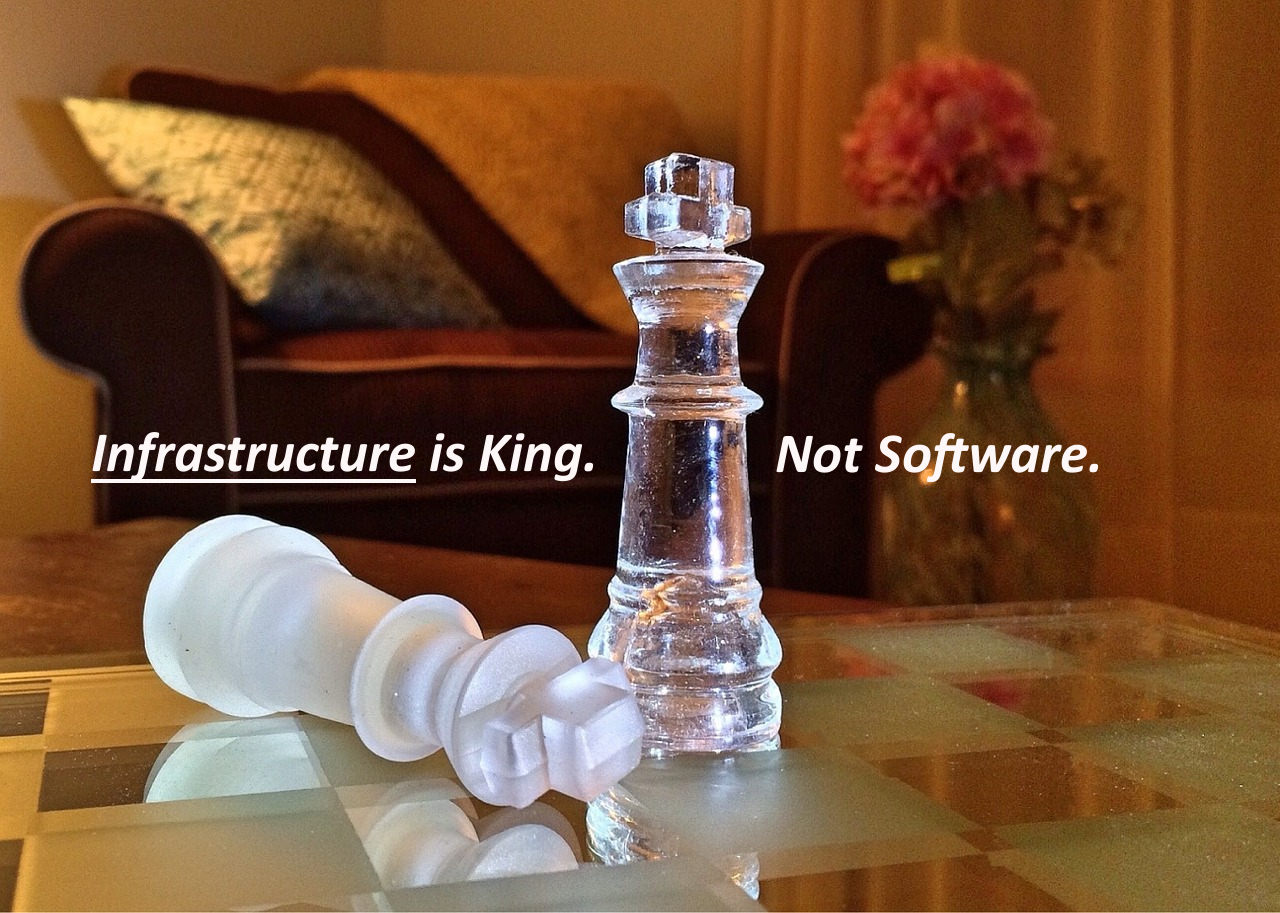Infrastructure is King. Not Software.
How’s that for challenging current thinking that software is the key to digital transformation? Truth is they’re both important but for different reasons, and with so much attention on the software side of the house, let’s take a few minutes and think about the platform. Infrastructure is the foundation for your products and services and it needs to run reliably and cost efficiently, and flexibly scale in all the ways your software and innovative future business plans may take you. Traditional infrastructure isn’t inherently built to meet all of these demands, so to succeed in your transformation program, rethinking the approach to infrastructure is a key step.
Before we dig too far, we need to set some guardrails around what we mean by “digital transformation.” Digital transformation is an enterprise-wide metamorphosis that includes process, product, and cultural change; it is a broad business encompassing program that will bring a dramatic seismic shift to your organization. The necessity and urgency for transformation is due to 3 main drivers:
- Changing technology available to us
- Changing expectations from our customers
- Changing competition in the market
This leaves IT with a familiar woe – how do you reinvent IT to focus on new products which delight the customers as the market demands, while still keeping existing systems running reliably and consistently?
The answer starts with a new approach to operations and infrastructure.
Traditional Infrastructure Was Designed with Industrial Era Thinking
As we look back at the last 20+ years it’s fair to say that we have run our operations as the business environment required. Infrastructure of the past fit the needs of back office IT where applications and services were slow to change. Because there were minimal outside expectations or pressures for change, infrastructure grew incrementally based on an internal IT clock. Often IT funding was limited, which meant limited staff, and because of this IT had to develop and create systems from scratch. During budget season IT leaders often had to guess what the business needs would be for the next 12+ months and set aside capital, just in case project directions changed. Often the choice was to overprovision because going back to the well for the funding of new equipment or software was not an option if a new need or priority popped up.
The Digital Age has forced a challenge to eliminate the cost, speed, and scale barriers of these same legacy processes and systems.
To enable IT to be fast moving and innovative it is necessary to free up resources and staff consumed with maintaining the old, especially infrastructure. Teams need to be unfettered from non-business-value work and given freedom to embrace new priorities along with the runway to stop and start quickly if the priorities change. To do this you will have to approach infrastructure in a new way.
Re-imagine the Building Blocks of Infrastructure
IT Leaders (and their teams) need to rethink their definition of infrastructure, and be willing to integrate new solutions into the foundational platform. The good news is that there are new technologies and methods emerging. Cloud, hyperconvergence, and utility delivery are three options available today that can help crack the puzzle of creating infrastructure headroom.
Cloud
The cloud promise includes reliability, lower costs, and scale. But, when looking at an all-in cloud environment, CIOs are finding the cloud as a full enterprise solution does not always deliver on that promise.1 Managing across multiple cloud vendors can add layers of complexity both in SLA delivery, application integration, and privacy and security concerns. Cost savings can be a mixed bag; sometimes the cloud can cost you more.
But, there are many systems that are perfect candidates for the cloud, such as human resource systems, back-up and disaster recovery, anti-spam, and even email, where integration is simple and there is value in un-tethering IT from the routine support duties these programs require. The cloud is an option, but you need to be strategic and thoughtful in your planning and approach to this as an all-in enterprise solution.
Hyperconvergence
Critical core business applications are candidates for on-premises delivery where integration efforts and service levels can be directly controlled and secured. But, delivery built on legacy infrastructure won’t provide for the flexibility needed. Ramping up disk space or new servers for example, takes time to implement in a typical IT shop and protracted time in today’s climate is not a win.
Hyperconvergence is an option to address these problems. Hyperconvergence is generally defined as “a type of infrastructure system with a software-centric architecture that tightly integrates compute, storage, networking and virtualization resources and other technologies from scratch in a commodity hardware box supported by a single vendor”2.These solutions are designed to scale, designed to self-heal, and touted to require less resource to monitor and manage. The attraction here is that this is all within your own data centers.
Hyperconverged systems are worth looking at for those core systems you just have to keep in house – price may be a factor, but when comparing costs, evaluate traditional network and system administration soft costs as part of the offset; with hyperconverged solutions, the product value proposition includes less administration and resource time. Don’t forget to factor in and plan for your disaster recovery solution when looking at hyperconvergence!
Utility IT Delivery
Beyond new technologies, the digital age has ushered in new business models. Uber is the classic example of that. IT infrastructure delivered as a utility is another business model shift, but one aimed directly at solving for infrastructure design and management cost and time limitations. Utility delivery of infrastructure, whether on premises or in the cloud, is a pay-as-you-grow flex model. From WAN to LAN, all components are defined as measurable units that include hardware, software tools, and human administration as part of the complete cost unit. In this model you pay by the unit only when it’s active in production, and you add or delete components at any time. That means no more capital outlay for hardware or for management tools, and the soft administration costs are baked in. Just like the power company, utility IT delivery is based on repeatable and consistent reference architectures, minimizing variables and consequently allowing scale.
It Always Comes Back to the People
Regardless of which technology or approach you take to adapt to the demands of today’s changing landscape (cloud, hyperconvergence, utility IT), there is one other element that is critical to the digital transformation program’s success: That is to embrace and coach your team through the cultural changes that will occur.
All of the options we’ve discussed will disrupt the roles and responsibilities in some fashion. If you do not address the disruptive environment that transformation brings to your team, your program will fail.
If you use the cloud will there be less servers and systems for the system administrators to manage? Yes, it can mean that. If you use a hyperconverged solution, will it require less administrative staff to maintain it – that’s the selling point behind the product! Does utility IT mean less infrastructure staff is needed to do the implementation and management of the WAN and LAN – yes. But, this doesn’t have to mean the demise of your talented infrastructure team.
If you need business enabling products and services to be the priority, you need to shift your staff’s focus. If you are clear in the strategic mission behind the transformation, transparent in what role each team member plays in meeting the mission, and leadership understands and supports the value of the people it employs and authentically helps coach and retrain the talent where applicable, you will have created a culture that can withstand the uncomfortable nature of transformation.
Infrastructure is King
A reliable and quickly scalable platform within the enterprise is required because infrastructure is the foundation of every piece of software, product, service and customer touch point that your organization creates. The traditional approach to IT infrastructure won’t get you there, but you have options.
Whether it’s the cloud, hyperconvergence, utility infrastructure delivery or some combination – a shift is required. Your Digital Age strategy must include many elements, but don’t forget the cornerstone, an evolved reincarnation of your infrastructure platform and the roles and skills of the team that owns it. Infrastructure has never been so important!
Sources:
1 Earls, Alan R. “Cloud Migration Strategies for a Hybrid Cloud World.”SearchCloudComputing. TechTarget, n.d. Web. 19 July 2016. http://searchcloudcomputing.techtarget.com/feature/Cloud-migration-strategies-for-a-hybrid-cloud-world
1 “Does Cloud Computing Really Save You Money?” Tuliva. N.p., 11 June 2015. Web. 19 July 2016. http://tuliva.com/cloud-computing/does-cloud-computing-really-save-you-money/
2 Rouse, Margaret. “What Is Hyper-convergence?” SearchVirtualStorage. TechTarget, Apr. 2014. Web. 19 July 2016. http://searchvirtualstorage.techtarget.com/definition/hyper-convergence
Author note: While the opinions and points made in this article are completely those of the author, Ms. Carroll is currently employed by an IT infrastructure utility company.






Trackbacks/Pingbacks